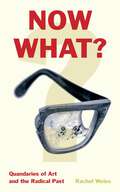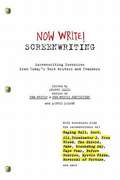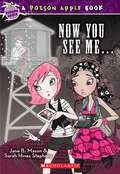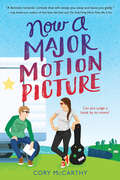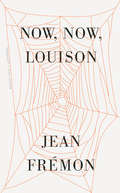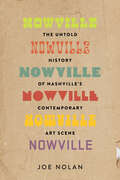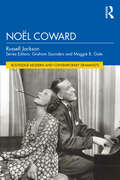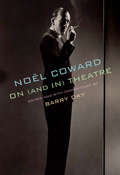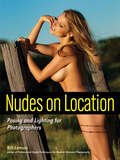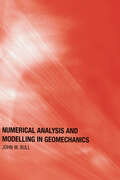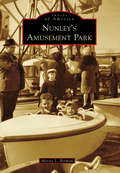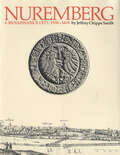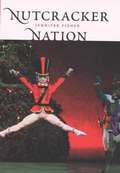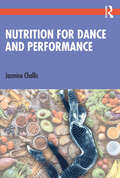- Table View
- List View
Now What?: Quandaries of Art and the Radical Past
by Rachel WeissNow What? is an innovative exploration of artworks and films that return to radical histories subject to erasure or otherwise lost or occluded over time. The moments returned to—the Cuban Revolution, Chile’s 1973 coup d’état, the ambiguous 1989 “revolution” in Romania, and the mayhem surrounding the Red Army Faction in 1970s West Germany—stand as historical watersheds, foundational and precipitate moments in the history of radical politics. Delving into these key historical moments by way of Tania Bruguera’s 2009 performance Tatlin’s Whisper in Havana, filmmaker Patricio Guzmán’s decades-long cycle of returns to Allende’s Chile, Harun Farocki and Andrei Ujica’s Videograms of a Revolution, Corneliu Porumboiu’s 12:08 East of Bucharest, the film Germany in Autumn, and Gerhard Richter’s October 18, 1977 suite of paintings, Rachel Weiss convincingly threads these works together through subtle and illuminating reflections on the complex dynamics involved in historical trauma and memory, addressing key questions about the meanings and uses of the past.
Now Write! Screenwriting
by Ellis Sherry Laurie LamsonAn essential handbook featuring never-before-published writing exercises from the acclaimed screenwriters of Raging Bull, Ali, Terminator 2, Fame, Groundhog Day, Cape Fear, "Lost", "True Blood", "The Shield", and many other hit films and television shows. Now Write! Screenwriting-the latest addition to the Now Write! writing guide series-brings together the acclaimed screenwriters of films like the Oscar-winning Raging Bull, Oscar- nominated Ali, era-defining blockbuster Terminator 2, musical classic Fame, hit series "Lost" "True Blood" and "The Shield," Groundhog Day, Cape Fear, Chicken Run, Reversal of Fortune, Before Sunrise, Mystic Pizza, Indecent Proposal, and many more, to teach the art of the story. *Learn about why it is sometimes best to write what you don't know from Christina Kim ('Lost') *Find out how Stephen Rivele (Ali, Nixon) reduces his screenplay ideas down to their most basic elements, and uses that as a writing guide *Learn why you should focus on your character, not your plot, when digging yourself out of a plot home from Danny Rubin (Groundhog Day) *Take tips from Karey Kirkpatrick (Chicken Run, The Spiderwick Chronicles) on how to give an inanimate object intense emotional significance *Let Kim Krizan (Before Sunrise, Before Sunset) teach you how to stop your internal critic dead in his tracks This lively and easy-to-read guide will motivate both aspiring and experienced screenwriters. No other screenwriting book offers advice and exercises from this many writers of successful, iconic films. .
Now You See It and Other Essays on Design
by Michael Bierut"Design is a way to engage with real content, real experience," writes celebrated essayist Michael Bierut in this follow-up to his best-selling Seventy-Nine Short Essays on Design (2007). In more than fifty smart and accessible short pieces from the past decade, Bierut engages with a fascinating and diverse array of subjects. Essays range across design history, practice, and process; urban design and architecture; design hoaxes; pop culture; Hydrox cookies, Peggy Noonan, baseball, The Sopranos; and an inside look at his experience creating the "forward" logo for Hillary Clinton's 2016 presidential campaign. Other writings celebrate such legendary figures as Jerry della Femina, Alan Fletcher, Charley Harper, and his own mentor, Massimo Vignelli. Bierut's longtime work in the trenches of graphic design informs everything he writes, lending depth, insight, and humor to this important and engrossing collection.
Now You See Me... (Poison Apple #4)
by Jane B. Mason Sarah StephensBest friends Lena and Abby love searching through thrift stores for lost treasures. When they find an old Polaroid camera, they can't wait to try it out. But the photos that develop are troubling -- things that weren't really there appear in the pictures. Creepiest of all is the image of a boy, dark and angry looking. He shows up, over and over, clearer each time. Can the girls discover what the ghost boy wants -- before it's too late?
Now a Major Motion Picture
by Cory McCarthyFandom and first love collide for Iris on the film set for her grandmother’s famous high-fantasy trilogy. <p><p> Unlike the rest of the world, Iris doesn't care about the famous high-fantasy Elementia books written by M. E. Thorne. So it's just a little annoying that M. E. Thorne is her grandmother—and that Iris has to deal with the trilogy's crazy fans. <p><p> When Iris gets dropped in Ireland for the movie adaptation, she sees her opportunity: if she can shut down production, the Elementia craze won't grow any bigger, and she can finally have a normal life. Not even the rascally-cute actor Eamon O'Brien can get in her way. <p><p> But the crew's passion is contagious, and as Iris begins to find herself in the very world she has avoided her whole life, she realizes that this movie might just be amazing…
Now, Now, Louison
by Jean FrémonFinancial Times Book of the Year Financial Times Book of the Year Financial Times Book of the Year The extraordinary artist, the spider woman, the intellectual, the rebel, the sly enchantress, and the “good girl” sing together in this exuberant, lithe text beautifully translated by Cole Swensen. This brilliant portrait of the renowned artist Louise Bourgeois (1911–2010) shows a woman who was devoted to her art and whose life was also that of her century. The art world’s grande dame and its shameless old lady, spinning personal history into works of profound strangeness, speaks with her characteristic insolence and wit, through a most discreet, masterful writer. From her childhood in France to her exile and adult life in America, to her death, this phosphorescent novella describes Bourgeois’s inner life as only one artist regarding another can. Included as an afterword is Frémon’s essay about his own “portrait writing” and how he came to know and work with Louise Bourgeois.
Nowville: The Untold History of Nashville's Contemporary Art Scene
by Joe NolanThis is the origin story of Nashville&’s surging contemporary art scene told by the ones who were there before anyone else. Not a story about commercial spaces or official institutions—this is the story of moldy warehouse studios and improvised galleries, happy-kegger after-parties and front lawn art sales, exhibitions in apartment living rooms and secret art displays hidden in plain sight.Nowville is an oral history of the Nashville art scene beginning in the 1990s. Author Joe Nolan tracks down the city&’s art punks, art monks, radical art students, and visionary pioneers to share what made their moments in Nashville so special. He also offers insights into how this homespun movement powered by DIY innovating came to be a thriving creative community and a cornerstone of the city&’s contemporary allure.
Noël Coward (Routledge Modern and Contemporary Dramatists)
by Russell JacksonNoël Coward combines a fresh appraisal of major plays by one of the twentieth century’s most popular dramatists, with an account of critical and theatrical responses to his life and work.For almost the entirety of the twentieth century, Noël Coward was one of the UK’s most popular and celebrated playwrights. Refracting, rather than directly reflecting the social and personal issues of his time, his plays reveal tensions and contradictions in the theatre world that surrounded them. As well as critical responses to his work and the key themes that it foregrounds, seminal productions of The Vortex, Private Lives, Design for Living, Hay Fever, Blithe Spirit and more are examined to further elaborate on the radicalism of his approach to personal and social relationships, and the ways in which directors and actors have sought to achieve a sense of the disquiet felt by critics and audiences when they were first produced. This book explores the question of what Coward’s work can speak to for today’s modern audiences, assessing his standing in terms of how conditions have changed in the theatre and society more broadly since they were written.Part of the Routledge Modern and Contemporary Dramatists series, Noël Coward provides undergraduate students on Theatre Studies degrees and Modern Drama courses an essential and accessible guide to the playwright’s work and illustrates the influence of his drama on what theatre can tell us about our society.
Noël Coward on (and in) Theatre
by Noël CowardNoël Coward on theatre was as dazzling and entertaining as his masterful plays and lyrics. Here his ideas and opinions on the subject are brilliantly brought together in an extraordinary collection of commentary, lyrics, essays, and asides on everything having to do with the theatre and Coward's dazzling life in it.The book Noël Coward wanted, promised, threatened to write—and never did. Including essays, interviews, diary entries, verse, his views on his fellow playwrights: "My Colleague Will," Shaw, Wilde, Chekhov, Barrie, Maugham, Eliot, Osborne, Albee, Beckett, Miller, Williams, Rattigan, Pinter, and Shaffer. Coward on the critics—many of whom irritated him over the years but came to admire him: James Agate, Alexander Woollcott, Graham Greene, Kenneth Tynan among them. And on the plays he wrote, among them: The Vortex; Hay Fever; Private Lives; Design For Living; Blithe Spirit.Here is the Master on the producers who crossed his path: André Charlot, C. B. Cochran, Binkie Beaumont. And the actors in the Coward galaxy: John Gielgud, Laurence Olivier, Gertrude Lawrence, the Lunts, etc. . . . His views on the art of acting: auditions, rehearsals, learning the lines, clarity of delivery, timing, control, range, stage fright, fans, theater audiences, revivals, comedy, "the Method," plays with a "message," taste, construction, "Star Quality," etc. . . . And last, but Noël Coward least, his experience in, and thoughts on: revue, cabaret, television, and musical theater, Bitter Sweet, Conversation Piece, Pacific 1860, After the Ball, Ace of Clubs, Sail Away, The Girl Who Came to Supper, Words and Music, This Year of Grace, London Calling! . . . and much more. Ingeniously, deftly compiled, edited, and annotated by Barry Day, Coward authority and editor of The Noёl Coward Reader and The Letters of Noёl Coward.
Nudes on Location
by Bill LemonBill Lemon is a veteran shooter who has mastered the art of creating evocative nude and glamour images in an endless array of locations and scenarios, achieving striking, evocative portraits every time. In his newest book, Bill teaches readers how to re-create some of his favorite portrait looks outdoors, where the stakes are high, the light is every changing, and environmental unknowns lurk at every corner. Presenting 60 main images, Bill provides readers with a bottom-up look at the strategy used to create the shot -from the conceptualization, to the location scouting, to the camera and lens settings, to the posing and composition. You’ll discover great tips for inspiring the model’s confidence, creating graceful lines in the body, maximizing body contours with light an shadow to emphasize the model’s assets and downplay flaws, and more. In each of the sixty portrait sections, you’ll find supplemental images that show how lights and/or modifiers were positioned, how image flaws were corrected, and/or review alternate poses that will help the model build variety in her portfolio.
Numbers in Graphic Design
by Roger Fawcett-TangFocusing on how graphic designers tackle the ordering of number-heavy information, this book shows how the best design minds around grapple with timetables, annual reports and other data-rich documents. It also includes a chapter outlining the basic typographic and detailing rules relating to numbers.Featuring the work of such names as Stefan Sagmeister, Karin von Ompteda, Joost Grootens, Socket Studio, Stapelberg & Fritz, Form, Willi Kunz, Helmut Schmid, Build and Cartlidge Levene, Numbers in Graphic Design is bursting with inspirational examples of how to approach almost any design situation featuring numbers. Numbers in Graphic Design is the sourcebook for any designer who wants to be able to work with numbers creatively and with confidence.
Numbers in Graphic Design
by Roger Fawcett-TangFocusing on how graphic designers tackle the ordering of number-heavy information, this book shows how the best design minds around grapple with timetables, annual reports and other data-rich documents. It also includes a chapter outlining the basic typographic and detailing rules relating to numbers.Featuring the work of such names as Stefan Sagmeister, Karin von Ompteda, Joost Grootens, Socket Studio, Stapelberg & Fritz, Form, Willi Kunz, Helmut Schmid, Build and Cartlidge Levene, Numbers in Graphic Design is bursting with inspirational examples of how to approach almost any design situation featuring numbers. Numbers in Graphic Design is the sourcebook for any designer who wants to be able to work with numbers creatively and with confidence.
Numerical Algorithms: Methods for Computer Vision, Machine Learning, and Graphics
by Justin SolomonNumerical Algorithms: Methods for Computer Vision, Machine Learning, and Graphics presents a new approach to numerical analysis for modern computer scientists. Using examples from a broad base of computational tasks, including data processing, computational photography, and animation, the textbook introduces numerical modeling and algorithmic desig
Numerical Analysis and Modelling in Geomechanics
by John W. BullIn geomechanics, existing design methods are very much dependent upon sophisticated on-site techniques to assess ground conditions. This book describes numerical analysis, computer simulation and modelling that can be used to answer some highly complex questions associated with geomechanics. The contributors, who are all international experts in th
Numerical Computations: Third International Conference, NUMTA 2019, Crotone, Italy, June 15–21, 2019, Revised Selected Papers, Part II (Lecture Notes in Computer Science #11974)
by Yaroslav D. Sergeyev Dmitri E. KvasovThe two-volume set LNCS 11973 and 11974 constitute revised selected papers from the Third International Conference on Numerical Computations: Theory and Algorithms, NUMTA 2019, held in Crotone, Italy, in June 2019. This volume, LNCS 11974, consists of 19 full and 32 short papers chosen among regular papers presented at the the Conference including also the paper of the winner (Lorenzo Fiaschi, Pisa, Italy) of The Springer Young Researcher Prize for the best NUMTA 2019 presentation made by a young scientist. The papers in part II explore the advanced research developments in such interconnected fields as local and global optimization, machine learning, approximation, and differential equations. A special focus is given to advanced ideas related to methods and applications using emerging computational paradigms.
Nunley's Amusement Park
by Marisa L. BermanNunley's Amusement Park in Baldwin, New York, was a beloved family destination for Long Islanders from 1939 until it closed in 1995. The park's most notable attraction was its famed Stein & Goldstein carousel. The Nunley family established numerous amusement parks in the Long Island area, such as those found in Bethpage, Rockaway Beach, and Broad Channel. Nunley's Amusement Park, which was in operation for over 50 years, has a special place in the memories of multiple generations of Long Islanders. After the park closed, the rides and games were sold at auction. In protest, Long Islanders banded together to prevent the carousel from being disassembled and sold off separately. Recognizing the passion residents held for the park, Nassau County stepped in and purchased the beloved carousel, and an elaborate campaign was established for its restoration. The year 2012 marked the 100th anniversary of the famous Nunley's Carousel, which is currently in operation at Museum Row in Garden City, New York.
Nuremberg, a Renaissance City, 1500–1618
by Jeffrey Chipps SmithThis illustrated study of Renaissance Nuremberg explores the city&’s social and artistic history through the sixteenth century and beyond. The German city of Nuremberg reached the height of its artistic brilliance during the Renaissance, becoming one of the foremost cultural centers in all of Europe by 1500. Nuremberg was the home of painter Albrecht Dürer, whose creative genius inspired generations of German artists. However, Dürer was only one of a host of extraordinary painters, printmakers, sculptors, and goldsmiths working in the city. Following a map of the city&’s principal landmarks, Guy Fitch Lytle provides a compact historical background for Jeffrey Chipps Smith's detailed discussions of the city&’s social and artistic significance. Smith examines the religious function of art before and during the Reformation; the early manifestations of humanism in Nuremberg and its influence on the art of Dürer and his contemporaries; and the central role of Dürer&’s pedagogical ideas and his workshop in the dissemination of Renaissance artistic concepts. Finally, Smith surveys the principal artists and stylistic trends in Nuremberg from 1500 to the outbreak of the Thirty Years War. Nuremberg: A Renaissance City, 1500-1618 contains biographical sketches of forty-five major artists of the period, plus more than three hundred illustrations depicting the city and its most magnificent artistic treasures.
Nuremberg, a Renaissance City, 1500–1618
by Jeffrey Chipps SmithThis illustrated study of Renaissance Nuremberg explores the city&’s social and artistic history through the sixteenth century and beyond. The German city of Nuremberg reached the height of its artistic brilliance during the Renaissance, becoming one of the foremost cultural centers in all of Europe by 1500. Nuremberg was the home of painter Albrecht Dürer, whose creative genius inspired generations of German artists. However, Dürer was only one of a host of extraordinary painters, printmakers, sculptors, and goldsmiths working in the city. Following a map of the city&’s principal landmarks, Guy Fitch Lytle provides a compact historical background for Jeffrey Chipps Smith's detailed discussions of the city&’s social and artistic significance. Smith examines the religious function of art before and during the Reformation; the early manifestations of humanism in Nuremberg and its influence on the art of Dürer and his contemporaries; and the central role of Dürer&’s pedagogical ideas and his workshop in the dissemination of Renaissance artistic concepts. Finally, Smith surveys the principal artists and stylistic trends in Nuremberg from 1500 to the outbreak of the Thirty Years War. Nuremberg: A Renaissance City, 1500-1618 contains biographical sketches of forty-five major artists of the period, plus more than three hundred illustrations depicting the city and its most magnificent artistic treasures.
Nureyev
by Clive BarnesA biography of the famous dancer as well as a chronology and a listing of roles and performances during the course of his career, which ended with his death in 1993.
Nureyev: The Life
by Julie KavanaghRudolf Nureyev had it all: beauty, genius, charm, passion, and sex appeal. No other dancer of our time has generated the same excitement, for both men and women, on or off the stage. With Nureyev: The Life, Julie Kavanagh shows how his intense drive and passion for dance propelled him from a poor, Tatar-peasant background to the most sophisticated circles of London, Paris, and New York. His dramatic defection to the West in l961 created a Cold War crisis and made him an instant celebrity, but this was just the beginning. Nureyev spent the rest of his life breaking barriers: reinventing male technique, "crashing the gates" of modern dance, iconoclastically updating the most hallowed classics, and making dance history by partnering England' s prima ballerina assoluta, Margot Fonteyn--a woman twice his age. He danced for almost all the major choreographers--Frederick Ashton, George Balanchine, Kenneth MacMillan, Jerome Robbins, Maurice Béjart, Roland Petit--his main motive, he claimed, for having left the Kirov. But Nureyev also made it his mission to stage Russia's full-length masterpieces in the West. His highly personal productions of Swan Lake, The Nutcracker, Raymonda, Romeo and Juliet, and La Bayadère are the mainstays of the Paris Opéra Ballet repertory to this day. An inspirational director and teacher, Nureyev was a Diaghilev-like mentor to young protégés across the globe--from Karen Kain and Monica Mason (now directors themselves), to Sylvie Guillem, Elisabeth Platel, Laurent Hilaire and Kenneth Greve. Sex, as much as dance, was a driving force for Nureyev. From his first secret liaison in Russia to his tempestuous relationship with the great Danish dancer Erik Bruhn, we see not only Nureyev's notorious homosexual history unfold, but also learn of his profound effect on women--whether a Sixties wild child or Jackie Kennedy and Lee Radziwill or the aging Marlene Dietrich. Among the first victims of AIDS, Nureyev was diagnosed HIV positive in 1984 but defied the disease for nearly a decade, dancing, directing the Paris Opéra Ballet, choreographing, and even beginning a new career as a conductor. Still making plans for the future, Nureyev finally succumbed and died in January l993. Drawing on previously undisclosed letters, diaries, home-movie footage, interviews with Nureyev's inner circle, and her own dance background, Julie Kavanagh gives the most intimate, revealing, and dramatic picture we have ever had of this dazzling, complex figure. NOTE: This edition does not include photos.
Nurseries: A Design Guide
by Mark DudekArchitecture can inspire young children; the very shape and form of a daycare center can not only stimulate their imagination but can help children form strong relationships and help promote development. This design guide presents all the elements of building design that combine to create the very best environment for young children and the people who work with them, including building materials, multi-functional spaces and design scaled to suit small children.
Nursery Décor
by Debra QuartermainDecorate baby's room with the delightful accessories presented in this unique book. Author Debra Quartermain expertly guides readers through creating four special themes for baby's room decor: "The Enchanted Garden," "Boys, Bears, & Baseball," "Sail on a Sea of Stars," and "B is for Baby. " Using felt and fabrics, readers are shown how to create 40 different accessories to fill the themed nurseries, including pillows, toys, stuffed animals, blankets, mobiles, frames, bookends, a toy box, and a rug. Painting tips and ideas for window treatments are also featured. Detailed step-by-step instructions Perfect for creating a special gift for baby Suitable for any skill level Full-size patterns are included
Nutcracker Nation: How an Old World Ballet Became a Christmas Tradition in the New World
by Jennifer FisherThe Nutcracker is the most popular ballet in the world, adopted and adapted by hundreds by hundreds of communities across the United States and Canada every Christmas season. In this entertainingly informative book, Jennifer Fisher offers new insights into the Nutcracker phenomenon, examining it as a dance scholar and critic, a former participant, an observer of popular culture, and an interviewer of those who dance, present, and watch the beloved ballet. Fisher traces The Nutcracker's history from its St. Petersburg premiere in 1892 through its emigration to North America in the mid-twentieth century to the many productions of recent years. She notes that after it was choreographed by another Russian immigrant to the New World, George Balanchine, the ballet began to thrive and variegate: Hawaiians added hula, Canadians added hockey, Mark Morris set it in the swinging sixties, and Donald Byrd placed it in Harlem. The dance world underestimates The Nutcracker at its peril, Fisher suggests, because the ballet,is one of its most powerfully resonant traditions. After starting life as a Russian ballet based on a German tale about a little girl's imagination, The Nutcracker has become a way for Americans to tell a story about their communal values and themselves.
Nutrition for Dance and Performance
by Jasmine ChallisNutrition for Dance and Performance is the first complete textbook written by an experienced dietitian specialising in the field of dance nutrition. It seeks to provide both dancers-in-training and instructors with practical advice on dance nutrition for health and performance. It is also highly relevant for dance professionals. With an in-depth and extensive coverage on all nutrition topics relevant to dancers, this book covers nutrition for the scenarios dancers face, including day-to-day training and rehearsals, peak performance, injuries, immunonutrition, nutrition and stress management. Information is included on topics applicable to individual dancers including advice for dancers with Type 1 diabetes and clinical conditions relating to gut health. The book guides the reader through the macronutrients making up the diet, their chemical structure and their role in health and optimal performance. Readers are shown how to estimate energy and nutrient needs based on their schedule, type of dance undertaken and personal goals before considering the practical aspects of dance nutrition; from nutrition planning to dietary supplements, strategies for assessing the need to alter body composition and guidance on undertaking health-focused changes. Nutrition for Dance and Performance combines and condenses the author’s knowledge and many years of experience working in the dance industry to translate nutrition science into a practical guide. Bringing together the latest research in dance science and nutrition, this book aims to be a trusted reference and practical textbook for students of Dance, Dance Nutrition, Dance Performance, Sport Nutrition and Sport Science more generally as well as for those training in the dance industry, dance teachers and professionals. Jasmine Challis is a freelance Registered Nutritionist (UK Association for Nutrition) and Dietitian registered with the Health Care Professions Council, and is on the UK Sport and Exercise Nutrition Register (SENR) focusing on dance. She completed an MRes in Sport and Exercise Science in 2018. She is on the Dance Medicine and Science Expert Panel for One Dance UK and is on the board of The Bridge Dance Project. She has worked across the dance field for over 30 years giving talks, running workshops and providing 1:1 sessions for dancers and dance students.
Nutrition for Dance and Performance
by Jasmine ChallisNutrition for Dance and Performance is the first complete textbook written by an experienced dietitian specialising in the field of dance nutrition. It seeks to provide both dancers-in-training and instructors with practical advice on dance nutrition for health and performance. It is also highly relevant for dance professionals. With an in-depth and extensive coverage on all nutrition topics relevant to dancers, this book covers nutrition for the scenarios dancers face, including day-to-day training and rehearsals, peak performance, injuries, immunonutrition, nutrition and stress management. Information is included on topics applicable to individual dancers including advice for dancers with Type 1 diabetes and clinical conditions relating to gut health. The book guides the reader through the macronutrients making up the diet, their chemical structure and their role in health and optimal performance. Readers are shown how to estimate energy and nutrient needs based on their schedule, type of dance undertaken and personal goals before considering the practical aspects of dance nutrition; from nutrition planning to dietary supplements, strategies for assessing the need to alter body composition and guidance on undertaking health-focused changes. Nutrition for Dance and Performance combines and condenses the author’s knowledge and many years of experience working in the dance industry to translate nutrition science into a practical guide. Bringing together the latest research in dance science and nutrition, this book aims to be a trusted reference and practical textbook for students of Dance, Dance Nutrition, Dance Performance, Sport Nutrition and Sport Science more generally as well as for those training in the dance industry, dance teachers and professionals. Jasmine Challis is a freelance Registered Nutritionist (UK Association for Nutrition) and Dietitian registered with the Health Care Professions Council, and is on the UK Sport and Exercise Nutrition Register (SENR) focusing on dance. She completed an MRes in Sport and Exercise Science in 2018. She is on the Dance Medicine and Science Expert Panel for One Dance UK and is on the board of The Bridge Dance Project. She has worked across the dance field for over 30 years giving talks, running workshops and providing 1:1 sessions for dancers and dance students.
